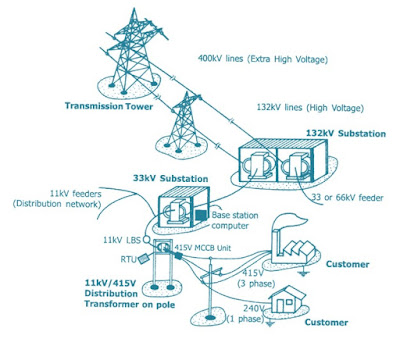In electric power Transmission and Distribution, power is transmitted at a voltage level of 400 kV to reduce losses and then at the substation, it is stepped down to 132 kV at which electric power is transmitted and then at substation it is again stepped down to 33 kV. Power is then transmitted at 33 kV to the substation wherefrom power will be distributed as shown in figure below.
The question arises, why don’t we directly step down the 400 kV to 33 kV instead of using so many Transformers?
Following are some interesting points which will make it clear:
-
If we stepped down 400 kV/33 kV then the current would be 12 to 13 times higher and the wires would have to be correspondingly heavier to transmit power at low voltage level of 33 kV.
- The 400 kV/33 kV Transformer would be impractical. If we assume a core type Transformer as is mostly the case, we have two limbs. We cannot wind the entire 400 kV winding in one limb and the other 33 kV winding on the other limb. The flux leakage would be too high. So we have to go for a scheme in which part of the 400 kV winding and part of 33 kV winding are wound on both limbs. This would reduce the flux leakage but it also means we have to provide insulation between the turns of 400 kV winding and the turns of 33 kV winding located on the same limb. This insulation requirement makes the 400 kV/33 kV Transformer realization impractical. Impractical because the insulation required would be too costly and likely to fail often.
- Suppose there are four 400 kV/132 kV Transformers feeding Northern districts, Southern districts, Eastern districts and Western districts respectively. Fault at any one Transformer can be easily isolated and only those districts would be unaffected. This would not be the case if we have a single 400 kV/33 kV Transformers feeding all the districts. By having four 400 kV/132 kV Transformers we achieve what is called fault isolation.
- Suppose the same thing as described above. In the case of four 400 kV/32 kV Transformers, all the four district zones are supplied by 132 kV lines. But in the case where all the districts were supplied by the single 400 kV/33 kV Transformer, the power is transmitted through 33 kV lines. Is it more economical to transmit power at 132 kV or 33 kV?
-
The obvious answer is at 132 kV. That is why we do not step down all the way to 33kV but only to 132 kV. Now lets us say there are three northern districts. At the main North zone substation the voltage would be stepped down from 132 kV/66 kV and at each district substation the voltage would be stepped down from 66 kV/33 kV. This scheme is more economical than directly transmitting power to all the districts at 33 kV because of considerable less transmission loss involved.
Thank you!

A very common question really nicely explained
A very common question really nicely explained.
I totally satisfied this answer.
thanku.
Hello i need more materials on this post if possible to mail
Thanks